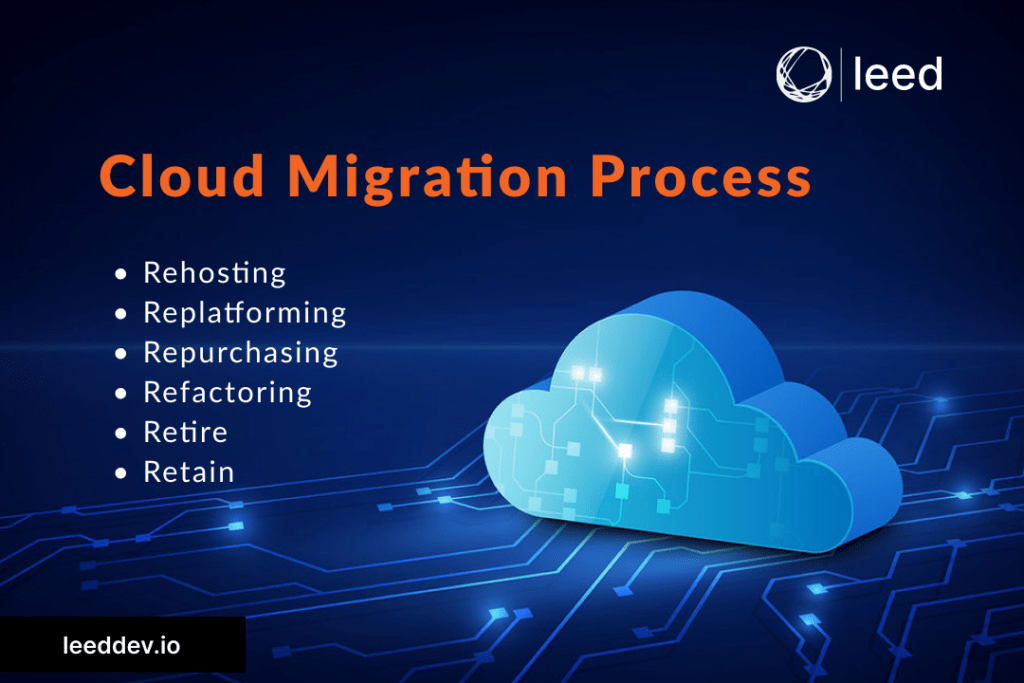Finding ways to make your data secure and easily accessible? Are you considering moving your organization’s data, applications, and infrastructure to the cloud? If so, it’s crucial to have a solid cloud migration strategy. It will help to ensure a successful and smooth transition. Let’s look at what cloud migration strategy is and what’s the process.
Read also: How Can Google Ads Help You Advance Your Business Goals
6 R’s of Cloud Migration Strategy
Cloud migration strategy refers to moving data and other business elements from an organization’s on-premises infrastructure to the cloud. The goal is to enable organizations to take advantage of the scalability, flexibility, and cost-effectiveness of cloud computing. Cloud migration strategies also minimize disruptions to business operations. The 6 R’s of cloud migration strategy are:
Rehosting
Also known as “lift and shift”. This involves moving the existing applications and data to the cloud without making any changes. Rehosting can be automated with tools like AWS VM Import/Export and CloudEndure Migration.
Replatforming
This involves moving the existing applications to a different platform in the cloud. It could be done on another cloud provider or a different operating system. Replatforming consists of making a few further adjustments to optimize your landscape for the cloud.
Repurchasing
Repurchasing means moving to a different product. This means moving your applications to new, cloud-native app development. The most commonly used is a SaaS platform. Repurchasing might be your most cost-effective option if moving from a highly customized legacy landscape.
Refactoring
This means knowing how to develop web applications. This is typically done using cloud-native features. This involves changing the existing applications to improve their performance and scalability in the cloud.
Retire
Retire means to get rid of. This involves retiring applications or data that are no longer needed. The data can also be replaced with cloud-based alternatives. This can increase your savings and can boost the business case,
Retain
This means to retain migrating for now. In some cases, you might be wondering whether this application needs to be migrated or not. There is a need to upgrade this app or not. But you should only migrate what makes sense for the business.
Read also: Differences Between Google Cloud And Amazon Web Service
What is the Cloud Migration Process?
The steps involved in migrating to the cloud environment may vary based on the complexity and size of your company setup. If we were to create a general roadmap for the process following steps would be included:
Strategizing your Cloud Migration
Cloud migration planning is crucial because you can consider the resources and timelines required for the migration. You should know why you want to move and which strategy is best. A detailed plan can be developed for moving your workloads to the cloud.
Why plan?
By planning the migration, you can identify potential challenges that may arise during the process. It allows you to understand the dependencies and interconnections between different systems and applications and plan accordingly. Furthermore, it also enables you to track your progress against your goals over time.
Selecting the right platform
Now you want to decide the kind of model you want to adopt. Choosing the right platform can have a significant impact on the success and scalability of your migration. The right platform can provide the necessary resources and capabilities to support your workloads.
Which platform to choose?
Different types of cloud services are present. These include public, hybrid, private, or multi-cloud services like Google, Azure, or AWS. The benefit you need to choose depends on which best serves your current and future needs.
Migrating your Data and Apps is a crucial step
There is a need to plan accurately. Moving your apps and data to the cloud can help you reduce the costs associated with maintaining on-premises infrastructure. But security concerns should be kept in mind. You can also take advantage of the cloud provider’s resources and capabilities by migrating your apps and data to the cloud.
Why migrate your data?
Migrating your apps and data can also be a complex and time-consuming process. It requires careful testing, planning, and execution. However, migrating your apps and data can help you ensure compliance with relevant regulations and standards. This is because many cloud providers have built-in security and compliance features. Additionally, migrating your apps and data can provide your organization with greater flexibility and scalability.
Assessing the outcome
After migrating the data, it’s crucial to optimize it, maintain its security, and ensure easy accessibility. Real-time changes to critical infrastructure and predicting workload contentions can be monitored. In addition, you should assess the security of the stored data to meet regulatory compliance requirements. Such as HIPAA and GDPR.
Cloud Migration Services
Several services and tools are available for the cloud migration process. Leading IaaS providers AWS, Microsoft, and Google offer various cloud migration services and have free options available. A few examples of services include:
- Cloud Assessment- Evaluate the current IT environment and identify which assets are suitable for migration to the cloud.
- Disaster Recovery- Provides backup and recovery solutions for the migrated assets in the cloud.
- Database Migration- Migrates data from on-premises storage to cloud storage
- Migration Tracker- Helps to track the progress and status of data and applications being migrated from one environment
The Cloud & Internet, Are both of them the same?
The term “cloud Migration” is often confused with the internet, but both are different concepts. The cloud leverages the internet to provide access to resources. However, when individuals use the internet, they will likely utilize cloud services. Even from checking email to sharing photos on social media or watching videos on streaming platforms. Cloud services are also being used in these processes but with the help of the internet.
Cloud Migration Challenges
The challenges of Cloud Migration include the following:
- Security Issues: Maintaining the security of sensitive data in the cloud can be challenging.
- Vendor lock-in: Moving away from a particular cloud provider may involve re-architecting applications and data.
- Interoperability: Integrating existing systems with cloud services can sometimes be challenging. This can lead to compatibility issues.
- Internet Connectivity Required: The cloud relies on a stable and fast internet connection, which may not be available in all areas.
- Complexity: The migration process can be complex. Multiple stages and many parts are involved.
Conclusion
To summarize the entire discussion, a cloud migration strategy can bring numerous benefits to businesses of all sizes. The cost savings, accessibility, and disaster recovery benefits make it an attractive option for businesses to stay competitive. However, it is important to consider the potential challenges, such as security and interoperability concerns. Before embarking on a cloud migration project, complexity, and other concerns should also be considered. Businesses can minimize risks and maximize returns by carefully planning and executing a cloud migration strategy. Adopting a cloud migration strategy is crucial for businesses to stay competitive in today’s changing technology landscape.
FAQs
Q.No.1: What is a Cloud Migration Strategy?
Answer: Cloud Migration Strategy is the process of moving data, applications, and other business components from on-premises infrastructure to cloud-based environments.
Q.No.2: Why should a company consider a Cloud Migration Strategy?
Answer: A company should consider a Cloud Migration Strategy to reduce costs, improve scalability, increase agility, and enhance security.
Q.No.3: How long does it take to complete a Cloud Migration Strategy project?
Answer: The time it takes to complete a Cloud Migration Strategy project can vary depending on the size and complexity of the organization. Generally, it can take anywhere from several weeks to several months.
Q.No.4: What are some common challenges associated with Cloud Migration Strategy?
Answer: Some common challenges associated with Cloud Migration Strategy include data security, data transfer speed, data compatibility, and application performance.
Q.No.5: What are the different types of Cloud Migration Strategy?
Answer: The different types of Cloud Migration Strategy include lift-and-shift, re-platforming, and refactoring.
Q.No.6: How can a company ensure a successful Cloud Migration Strategy?
Answer: A company can ensure a successful Cloud Migration Strategy by having a clear plan, involving all stakeholders, testing extensively, and using the right tools and services.
Q.No.7: How much does a Cloud Migration Strategy cost?
Answer: The cost of a Cloud Strategy project can vary depending on factors such as the size of the organization, the complexity of the infrastructure, and the type of cloud platform being used.
Q.No.8: What are some popular cloud platforms used for Cloud Migration Strategy?
Answer: Some popular cloud platforms used for Cloud Migration Strategy include Amazon Web Services (AWS), Microsoft Azure, and Google Cloud Platform.
Q.No.9: Can Cloud Migration Strategy be done in stages?
Answer: Yes, Cloud Migration Strategy can be done in stages to reduce the impact on the organization and minimize downtime.
Q.No.10: How can a company choose the right Cloud Migration Strategy for their business?
Answer: A company can choose the right Strategy for their business by considering factors such as the complexity of the infrastructure, the goals of the organization, and the expertise of their IT team.
See more




